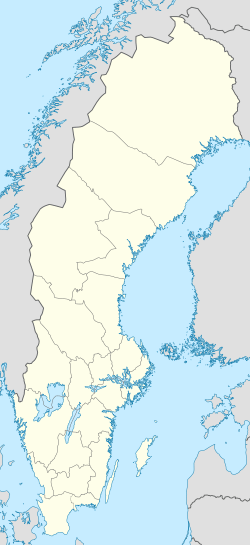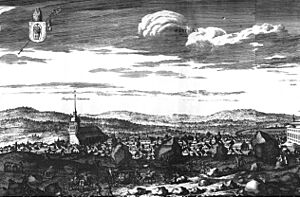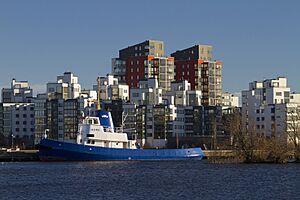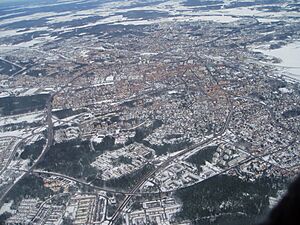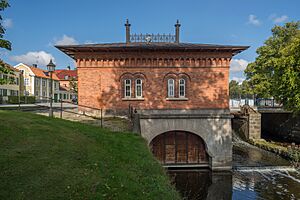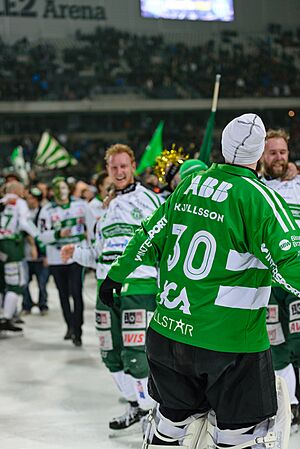Västerås facts for kids
Quick facts for kids
Västerås
|
|
|---|---|
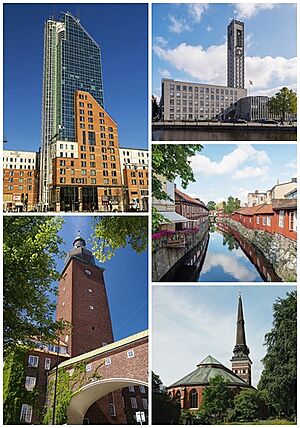
Clockwise from top left: Skrapan, Västerås City Hall, half-timbered buildings alongside Svartån river, Västerås Cathedral and Ottarkontoret
|
|
| Nickname(s):
Mälarstaden (The City of Mälaren), Gurkstaden (The Cucumber City)
|
|
| Country | |
| Province | Västmanland |
| County | Västmanland County |
| Municipality | Västerås Municipality |
| Area | |
| • City | 52.94 km2 (20.44 sq mi) |
| • Metro | 962.78 km2 (371.73 sq mi) |
| Elevation | 17 m (56 ft) |
| Population
(2019)
|
|
| • City | 127,799 |
| • Density | 2,094/km2 (5,420/sq mi) |
| • Metro | 154,049 (Västerås Municipality) |
| Time zone | UTC+1 (CET) |
| • Summer (DST) | UTC+2 (CEST) |
| Postal code |
721 00 – 728 20
|
| Area code(s) | (+46) 021 |
Västerås (say "VEST-er-OHSS") is a city in central Sweden. It sits on the shore of Lake Mälaren in the area called Västmanland. The city is about 100 kilometers (62 miles) west of Stockholm. In 2019, Västerås had a population of 127,799 people. It is the main city of Västerås Municipality and the capital of Västmanland County. It is also a city where a bishop lives.
Contents
Västerås: A City with a Long History

Västerås is one of the oldest cities in Sweden and Northern Europe. Its name comes from Västra Aros, which means "West River Mouth". This refers to where the Svartån river flows into Lake Mälaren. People have lived in this area since the Viking Age, even before the year 1000. In the early 11th century, Västerås was the second largest city in Sweden. By the 12th century, it became the home of a bishop.
Just outside Västerås city, you can find Anundshög. This is Sweden's largest burial mound. A "hög" is an old word for a mound or hill. It was built around 500 CE. This huge mound is over 67 meters (74 yards) wide and almost 9 meters (10 yards) high.
Over the next few centuries, a cathedral and a monastery were built. The beautiful Gothic cathedral was rebuilt by Birger Jarl and finished in 1271. The city's first official symbol, its City Arms, dates back to the late 1200s. There is also a castle in Västerås. King Gustav I took control of it and rebuilt it. Later, King Eric XIV was held prisoner there from 1573 to 1575.
King Gustav I also held a very important meeting in Västerås. This meeting was called the riksdag. During this meeting, a big decision was made to change Sweden into a Protestant country. This also meant reducing the power of the Catholic Church.
In 1623, the oldest secondary school in Sweden was built in Västerås. It was named Rudbeckianska gymnasiet after its founder, Johannes Rudbeckius.
During the 18th and 19th centuries, growing cucumbers became very popular in Västerås. Because of this, the city earned the nickname Gurkstaden, which means "the Cucumber City". It still has this fun nickname today!
Västerås Today: Industry and Lakeside Fun
Today, Västerås is well-known as an industrial city. It is also a major center for shopping and logistics (moving goods). The city wants to be known as Västerås – Mälarstaden, which means "Västerås—the city by Lake Mälaren". This is to attract visitors and new residents. It also aims to bring students to the local Mälardalen University, which has about 16,000 students.
To achieve this, the city uses a special logo for branding. It has also rebuilt old harbor areas to make them nicer places to live. Västerås has the largest commercial and recreational port on Lake Mälaren in Scandinavia. The lake has many islands, and you can take tourist boats to them every day in the summer.
The city also has a tall building nicknamed "Skrapan" (meaning "The Scraper"). On its 24th floor, you'll find Sky Bar, which is Sweden's highest-located cocktail bar.
Västerås used to host Power Big Meet, a huge yearly event for classic American cars. This event moved in 2017. However, a similar event called Västerås Summer Meet now takes place in the same spot.
Climate and Weather in Västerås
Västerås has a climate with cold winters and warm summers. Summers can be sunny but also have sudden rain showers. The sunniest weather happens when high-pressure systems block rain from the Atlantic Ocean. In July, daytime temperatures are usually around 22°C (72°F). Sometimes they can go above 25°C (77°F) or even 30°C (86°F).
Winters are usually cold with snow lasting for several months. Some winters can be milder with less snow. The weather changes a lot depending on where the air comes from. If it's from the Atlantic Ocean, temperatures might reach over 5°C (41°F). If it's from the Eurasian continent, temperatures might not rise above -15°C (5°F) even in the middle of the day. Lake Mälaren is usually frozen from December until the end of March.
The highest temperature ever recorded in Västerås was 36.0°C (96.8°F) on July 9, 1966. The lowest temperature was -36.5°C (-33.7°F) on January 24, 1875.
The Åkesta observatory, a place for studying stars, is located 4 kilometers (2.5 miles) north of the town.
| Climate data for Västerås (2003–2018 averages & extremes since 1901) | |||||||||||||
|---|---|---|---|---|---|---|---|---|---|---|---|---|---|
| Month | Jan | Feb | Mar | Apr | May | Jun | Jul | Aug | Sep | Oct | Nov | Dec | Year |
| Record high °C (°F) | 10.2 (50.4) |
11.3 (52.3) |
19.4 (66.9) |
25.9 (78.6) |
29.0 (84.2) |
33.6 (92.5) |
36.0 (96.8) |
35.2 (95.4) |
27.8 (82.0) |
20.5 (68.9) |
13.8 (56.8) |
12.1 (53.8) |
36.0 (96.8) |
| Mean maximum °C (°F) | 6.1 (43.0) |
6.4 (43.5) |
12.1 (53.8) |
18.5 (65.3) |
24.1 (75.4) |
26.4 (79.5) |
28.6 (83.5) |
27.4 (81.3) |
21.7 (71.1) |
15.7 (60.3) |
11.3 (52.3) |
7.3 (45.1) |
29.6 (85.3) |
| Mean daily maximum °C (°F) | −0.3 (31.5) |
0.2 (32.4) |
4.5 (40.1) |
11.6 (52.9) |
16.8 (62.2) |
20.1 (68.2) |
23.2 (73.8) |
21.3 (70.3) |
16.7 (62.1) |
10.0 (50.0) |
5.1 (41.2) |
1.8 (35.2) |
10.9 (51.7) |
| Daily mean °C (°F) | −2.8 (27.0) |
−2.6 (27.3) |
0.6 (33.1) |
6.5 (43.7) |
11.6 (52.9) |
15.2 (59.4) |
18.4 (65.1) |
17.0 (62.6) |
12.8 (55.0) |
6.9 (44.4) |
2.9 (37.2) |
−0.5 (31.1) |
7.2 (44.9) |
| Mean daily minimum °C (°F) | −5.2 (22.6) |
−5.3 (22.5) |
−3.3 (26.1) |
1.3 (34.3) |
6.3 (43.3) |
10.3 (50.5) |
13.5 (56.3) |
12.6 (54.7) |
8.8 (47.8) |
3.8 (38.8) |
0.6 (33.1) |
−2.8 (27.0) |
3.4 (38.1) |
| Mean minimum °C (°F) | −15.8 (3.6) |
−14.8 (5.4) |
−11.7 (10.9) |
−4.6 (23.7) |
−0.4 (31.3) |
4.5 (40.1) |
8.6 (47.5) |
5.8 (42.4) |
1.7 (35.1) |
−3.6 (25.5) |
−7.7 (18.1) |
−12.1 (10.2) |
−18.8 (−1.8) |
| Record low °C (°F) | −31.0 (−23.8) |
−31.8 (−25.2) |
−27.3 (−17.1) |
−19.8 (−3.6) |
−6.0 (21.2) |
−1.4 (29.5) |
2.0 (35.6) |
0.5 (32.9) |
−7.0 (19.4) |
−12.0 (10.4) |
−19.0 (−2.2) |
−27.0 (−16.6) |
−31.8 (−25.2) |
| Average precipitation mm (inches) | 45.2 (1.78) |
35.2 (1.39) |
26.5 (1.04) |
31.9 (1.26) |
44.5 (1.75) |
67.9 (2.67) |
71.2 (2.80) |
80.1 (3.15) |
44.5 (1.75) |
56.6 (2.23) |
55.7 (2.19) |
49.5 (1.95) |
608.8 (23.96) |
| Source: SMHI Open Data | |||||||||||||
How Västerås's Population Has Grown
| Year | Population | ||||||||
|---|---|---|---|---|---|---|---|---|---|
| 1970 |
116,725
|
||||||||
| 1975 |
117,911
|
||||||||
| 1980 |
117,487
|
||||||||
| 1985 |
117,706
|
||||||||
| 1990 |
119,761
|
||||||||
| 1995 |
123,728
|
||||||||
| 2000 |
126,328
|
||||||||
| 2005 |
131,934
|
||||||||
| 2010 |
137,207
|
||||||||
| 2015 |
145,218
|
||||||||
| 2020 |
155,551
|
||||||||
| 2023 |
159,662
|
||||||||
|
Source: SCB - Folkmängd efter region och år. |
|||||||||
Västerås's Economy: Big Industries and Shopping
Västerås has a strong economy, especially in industry and trade.
Important Industries in Västerås
In 1891, a small hydroelectric dam called the Turbine House was built on the Svartån river. This early way of making electricity helped a large company called ASEA grow in Västerås. ASEA made electrical equipment. Later, ASEA joined with another company to become ABB Group. Today, Västerås is home to the Swedish headquarters of ABB. Here, they make robots, drive systems for factories, and parts for power grids.
Several businesses have also started from ABB. One important one is Hitachi Energy. Another is Westinghouse Sweden, which makes fuel for nuclear power plants. This plant is in an industrial area called Finnslätten. As of 2014, Westinghouse Sweden had over 1000 employees. They have provided fuel to Ukraine since 2005.
Mälarenergi AB is a company owned by the city. It provides heating and electricity to Västerås and nearby areas. Their biggest plant is in Västerås. It is Sweden's largest combined heat and power plant. Its newest unit uses waste as fuel to create energy.
Other big companies in Västerås include:
- Bombardier Transportation: They make parts for trains.
- GE Power Sweden
- Enics
- Quintus Technologies AB: They make equipment for working with metals.
- Northvolt AB: They design and make batteries for electric vehicles and other industries.
Shopping and Trade in Västerås
Västerås became a city a long time ago because it was a good place for trade. Its location by the Svartån river and Lake Mälaren made it easy to move goods. Today, it is still a main center for logistics in Sweden. This is because it's in the middle of the busy Mälardalen region. It also has good connections with railways, waterways, and highways. For example, ICA AB, a big grocery company, has one of its main distribution centers here.
Västerås is also the city where the international clothing store H&M started. Their very first store opened in the city center in 1947.
Erikslund Shopping Center, just outside Västerås, was once Sweden's biggest mall. It is still a very large retail area, ranking third in sales after other big shopping areas in Sweden.
Sports Teams in Västerås
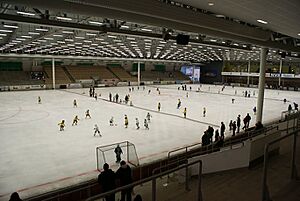
Västerås is home to several successful sports teams:
- Västerås SK (The Green and White): This team was started in 1904. It is the most successful bandy team in Sweden, with 22 Swedish Championships won. They play in ABB Arena Syd, which is the largest indoor arena for bandy in Sweden. The Bandy World Championship has been held in Västerås many times.
- VIK Västerås HK (VIK Västerås Hockey Klubb): This ice hockey club had its best season in 1992/1993. In 2000, the club faced money problems and had to restart in the lowest league. Today, they play in Hockeyallsvenskan, which is the second-highest league. Many famous hockey players are from Västerås, including Nicklas Lidström and Tommy Salo.
- Västerås SK (Football): In 2023, this football team made it to the top league of Swedish football, Allsvenskan. The last time they were in the premier division was in 1997.
- Other football clubs in Västerås include IFK Västerås FK, IK Franke, Skiljebo SK, Västerås IK, Syrianska IF Kerburan, and Gideonsbergs IF.
Famous People from Västerås
- Gerda Ahlm, artist
- Mattias Andréasson, singer
- Mikael Backlund, ice hockey player
- Maria Bonnevie, actress
- Ana Diaz, musician
- Lars Ekborg, comedian
- Embee, hip hop deejay and producer
- Fronda, rapper
- Frida Hansdotter, alpine skier
- Patrik Isaksson, swimmer
- Fredrik Johansson, musician
- Pontus Kåmark, football player
- Dagmar Lange, author
- Nicklas Lidström, ice hockey player
- Victor Lindelöf, footballer for Manchester United
- Magnus Lindgren, jazz musician
- Loreen, singer, winner of the Eurovision Song Contest 2012 and Eurovision Song Contest 2023
- Maria Montazami, television personality
- Markus Oscarsson, Olympic gold medalist in canoeing
- Pandora, singer
- Stefan Pettersson, footballer
- Promoe, rapper
- Jonny Rödlund, football player
- Pugh Rogefeldt, musician
- Linda Rosing, singer, model
- Tommy Salo, ice hockey player
- Ola Sandström, singer, songwriter
- Bobo Stenson, jazz pianist
- Gary Sundgren, football player
- Åsa Svensson, tennis player
- Esbjörn Svensson, jazz pianist
- Olof Thunberg, actor
- Tomas Tranströmer, poet
- Lars Wallin, fashion designer
- Mai Zetterling, actress and film director
Getting To and From Västerås
- Stockholm-Västerås Airport
- Västerås Central Station
See also
 In Spanish: Västerås para niños
In Spanish: Västerås para niños



